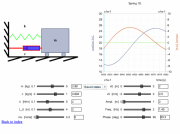 PITFS developed interactive flash animations that allowed students to fully explore and understand a phenomenon and ultimately gave them better intuition about the physical concepts presented in the course. Interactive animations for the following systems were created: single spring, rotating disk, double spring, double pendulum, falling rod, shaky table. Students were able to change the values of various parameters, animate the systems, and plot graphs of different variables.
PITFS developed interactive flash animations that allowed students to fully explore and understand a phenomenon and ultimately gave them better intuition about the physical concepts presented in the course. Interactive animations for the following systems were created: single spring, rotating disk, double spring, double pendulum, falling rod, shaky table. Students were able to change the values of various parameters, animate the systems, and plot graphs of different variables.